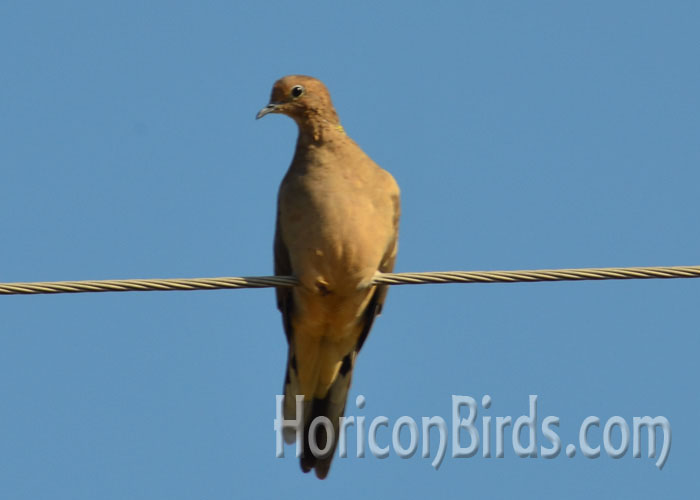|
Overcoming a Handicap in the Bird World
by Pam Rotella
1 October 2015
HoriconBirds.com
WHITE RIVER MARSH, WISCONSIN - Operation Migration had originally announced a departure date of September 20th for its 2015 guided migration. Then delays from unharvested crops in fields they'd need, then persistent fog or winds, prevented that flight until yesterday.
When daily delays would leave birdwatchers without cranes to watch, I'd often go birding at the marsh. On the 27th, I saw a mourning dove on a power line and took a short series of pictures. None of the pictures were as sharp as I would have liked, and the lighting wasn't very good, but I think the pictures are clear enough for my readers to see what I think is a severe handicap. Specifically, where are this bird's feet?

|
|
Mourning dove perches on a power line near White River Marsh, Wisconsin, 27 September 2015. Photo by Pam Rotella
|
Although none of my photos of this bird are perfect, I enlarged one of them and then used software for auto-corrections and brightening shadows. Notice in the picture below that the bird appears to be resting on its thighs. The photo does not show lower legs or feet.

|
|
Mourning dove photo enhancement appears to show missing legs and feet.
|
Whether this handicap originated with an injury or a congenital disorder, the dove has found a way to survive in the natural world. The extra hardship could explain the bird's athletic build, as more energy is needed to take off and land without the extra thrust of legs.
My initial reaction was to want to help the bird, but people I've known involved with wildlife rehabilitation would say that if a bird can survive on its own, then the bird should remain free. The dove is thinner than I'd like to see, but otherwise seems to be managing somehow.
We all know that the world is a dangerous place for birds. Injuries and deaths aren't uncommon. This bird has faced its challenges without human assistance, a story not often seen or heard because we weren't a part of it.
Hopefully the dove will never need human intervention, and can remain free and lead a near-normal life. The bird has a difficult situation, but its perseverance is an inspiration.
All original content including photographs © 2015 by Pam Rotella.
|